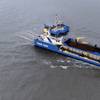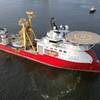A single oil spill can release 30,000 tonnes of oil into the ocean if two vessels collide. In grounding the high weight can lead to oil disaster, in the Baltic Sea up to 120,000 tonnes. This estimate does not include the new giant tankers, says a press release from Helsingin yliopisto (University of Helsinki).
The Gulf of Finland in the Baltic Sea is the riskiest of waterways in the world's oceans due to the high frequency of crossing vessels between Helsinki and Tallinn. Oil tanker traffic to Russia in particular has continued to increase despite a bleak financial outlook. The Gulf of Finland is famously difficult for maritime traffic as it is shallow and narrow and requires navigation around the many islands along the Finnish coast. In winter, darkness and ice make navigation even more challenging.
"The likelihood of an oil spill on the Gulf of Finland is higher than average. It is practically a miracle that we haven't seen major accidents yet," says researcher Annukka Lehikoinen from the University of Helsinki's Department of Environmental Sciences.
Lehikoinen is a member of the cross-disciplinary research group at the Kotka Maritime Research Centre.The group has studied the likelihood of different frequencies of hypothetical tanker collisions occurring on the Gulf of Finland and how often such collisions would lead to oil spills.
According to the results, the risk of collision-related oil spills could up to quadruple in the near future from the traffic amounts of 2007-2008. This would mean that such accidents would be likely to happen once every 24 years. However, these figures do not include cases where a tanker runs aground on a rock. Striking a rock is a more common type of accident on the Gulf of Finland, although the biggest oil spills usually result from collisions.
"We need to develop appropriate risk analysis in maritime academic culture. We should adapt the high quality risk culture of nuclear industry or aviation and support the interests of oil companies not to be involved in a disaster. There modeling is in a key role and we need scientific concepts that learn quickly from all possible information sources" says Professor Sakari Kuikka, the head of FEM group in University of Helsinki.
The frequency of accidents presented by the research group are based on observed and predicted traffic amounts on the Gulf of Finland, the number of events where ships encounter or overtake each other simulated from the traffic data, as well as on a model which predicts the likelihood of human error in evasive action.
"However, accidents are always individual cases and result from chains of events where many things go wrong at the same time -not to mention the number of other random contributing factors. We have considered these aspects fairly comprehensively, but there are many factors in the background that we are still in the process of identifying and analyzing," Lehikoinen points out.
Lehikoinen admits that evaluating the risk of oil spills is difficult since the topic is so abstract.
"I think the most important added value of a model like this is that it can be used to compare the changes caused by different events and measures to the risk level. This model will be further developed and applied to examine a range of risk management measures to help determine the most cost-effective solutions."













